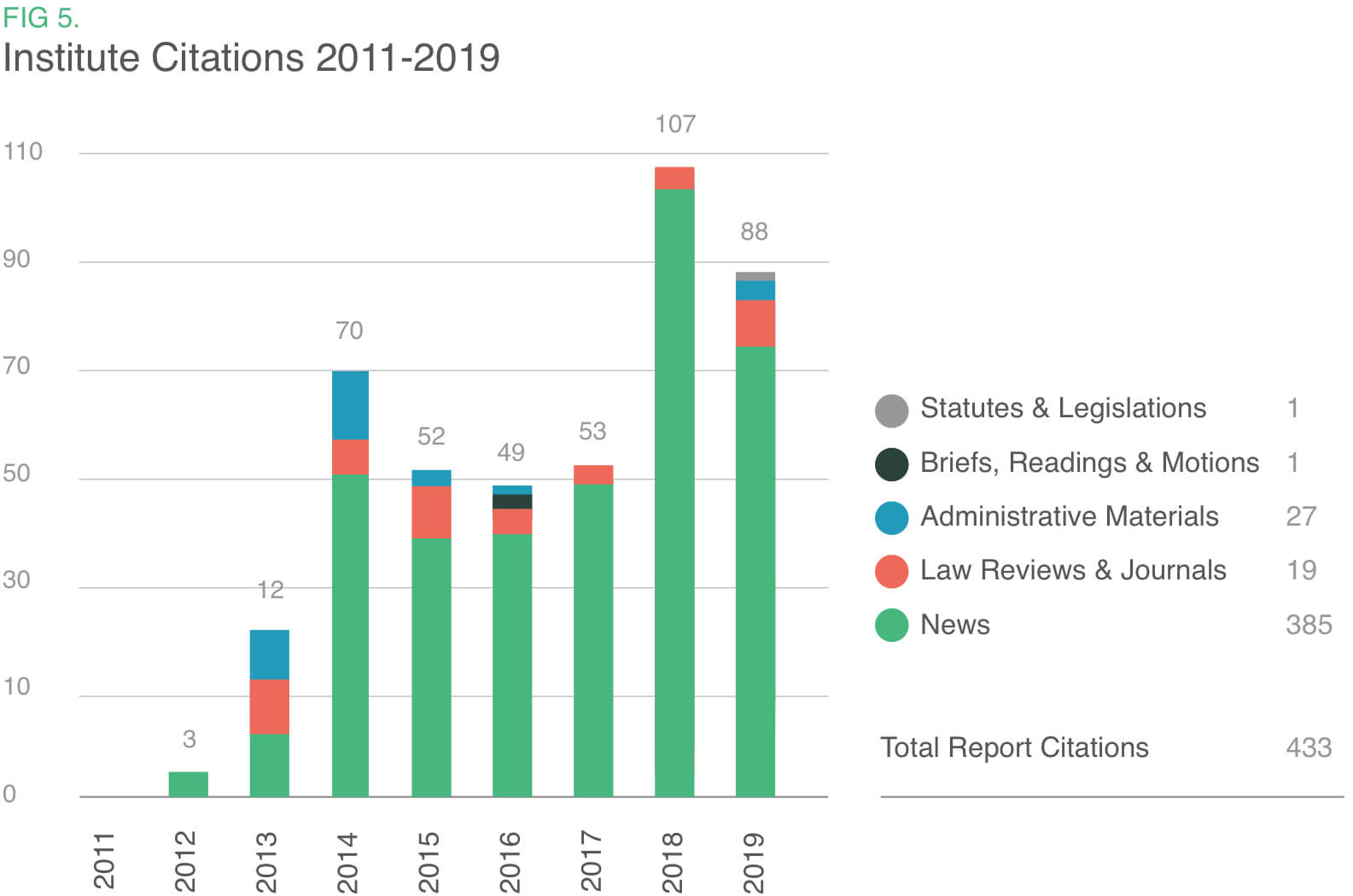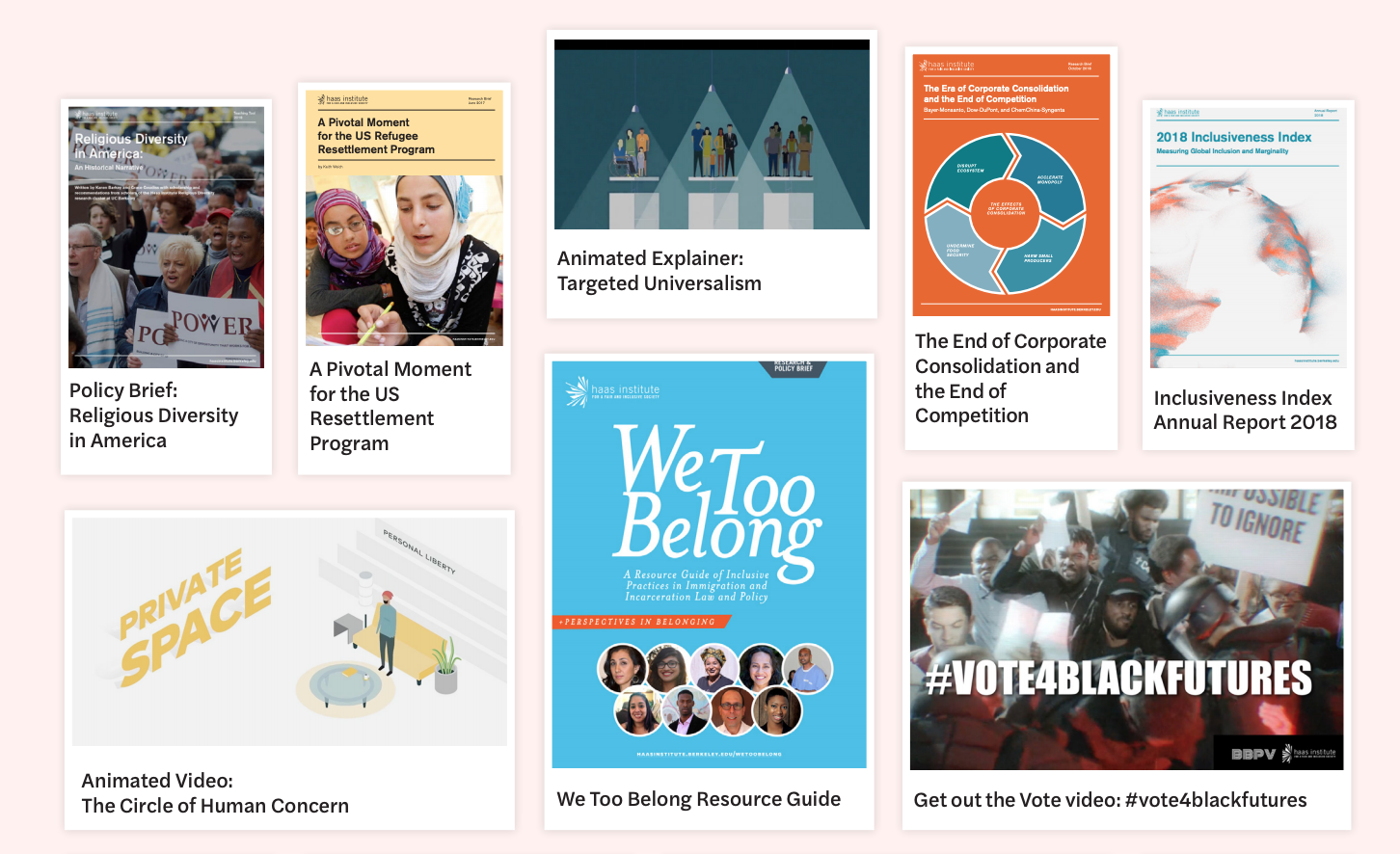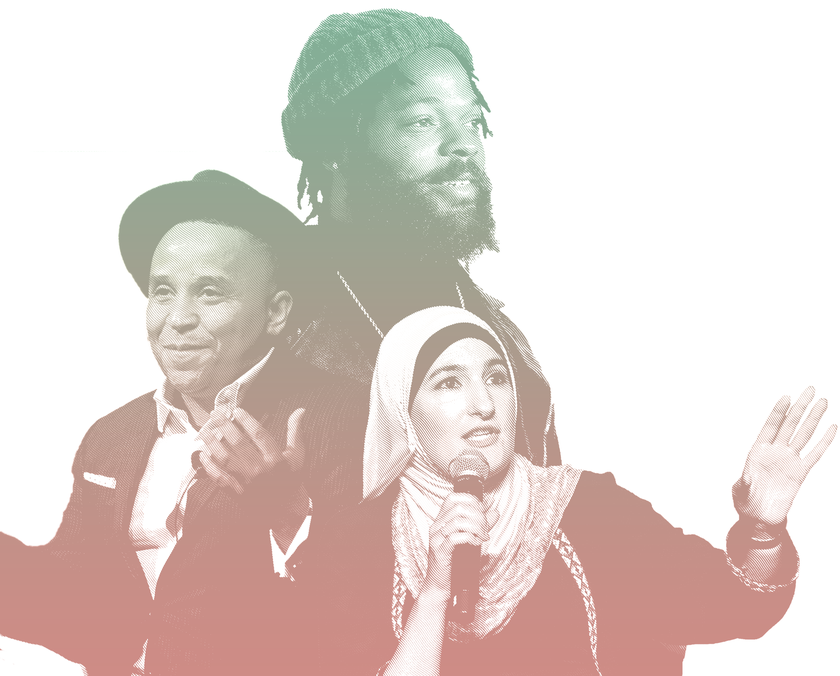ANOTHER KEY MEASURE of the Othering & Belonging Institute’s impact is where it has been successful in influencing scholarship and shaping public discourse. This work to shift public understanding and will is animated by a belief that today’s ecosystem of social change is best oriented towards a focus on belonging, which by our definition calls for the transformation of structures in society. This work is guided by the Institute’s position that to address any major injustice, from mass incarceration to homelessness, we must ultimately redefine who belongs—who is deserving of our care and concern and who gets to decide. The Institute has been actively involved in work that reframes equity objectives to answer these questions. In centering the concept and application of belonging, the Institute has pushed conversations and work beyond the confines of a focus on equity and inclusion, just as those terms underwent a shift from previous aspirations of diversity and equality. We have found that inclusion may bring formerly-excluded groups within spaces and institutions, but too often has left power and privilege within those places untouched and unexamined, let alone how they or their relationships with other structures are organized.
TESTIMONIAL
“There's a way in which they have influenced the language, the lexicon of how we think and talk about the issues that we're trying to address. So very rarely do you see a grantee who is transforming language in real time on the narrative space. They have contributed greatly around this construct of bridging and breaking. Are we creating pathways that either bridge or break individuals from feeling connected to a particular issue, which I think has been very helpful. So now our people are always asking: Is this a bridging or a breaking moment?”—Alvin Starks, Open Society Foundations
INFUSING NEW FRAMES & NARRATIVES
Since our first high-profile conference was held in 2015, and we launched our journal by the same name in 2016, it is clear that our efforts have contributed to belonging becoming a more salient frame and broadly-used social concept. See Figures 1 and 2 for the increase in major media mentions and online searches of the term “belonging” from 2011–2019. Notable figures who have served as keynote speakers at our conferences, such as New York Times columnist Charles Blow and social movement leader Rev. William Barber II of the Poor Peoples’ Campaign, have incorporated and used the language of othering and belonging in their own work, reinforcing the frame to an ever-larger network of people.
The Institute has tracked similar impacts with other key frames we have developed—for example, there was a measurable uptick in the media’s use of the term “targeted universalism” over the past five years. During the early years of the Institute, there were just six media references to the phrase, but since the first major public conference was held in 2015, the term has gotten more than 50 references by media outlets (see Figures 3 and 4).
In addition, the Institute’s efforts in highlighting “breaking and bridging” as a way to respond in an era of rapid global change have guided significant work in the social change sector. Breaking, which manipulates anxiety around change and results in a smaller “we,” has created the conditions for increased authoritarianism, rising nationalism, and at its most extreme threatens the existence of our living planet. Bridging, on the other hand, affirms our inherent connection to each other and our planet, celebrates our differences, incorporates our histories, and is based on an ethics of human dignity. Bridging calls on us to co-create a responsive government and create a bigger “we.”
Our work in advancing bridging has influenced much of our programmatic work, especially in our work to challenge dominant, exclusionary narratives and practices (see more in Impact Area 5). Since its earliest days, the Institute has prioritized its work around an understanding of how narratives and worldviews underpin our social, economic, and political dynamics and arrangements. The Institute has made developing and operationalizing an inclusive, strategic narrative a significant priority of its efforts to help shape public discourse, build effective movements, and influence work across a wide range of sectors.
Collective work that is driven by a shared narrative helps to build public support and power for mechanisms, such as government, that are necessary to achieve the scale of change we seek. The Institute’s definition of narrative calls for an effective, responsive government, care for the earth, and an unwavering belief in the shared humanity and belonging of all people. Narratives must also speak to a deep sense of both who we are and also who we are becoming. Giving rise to a new, shared identity—the building of a bigger we—is needed for the transformative change we seek.
Richmond community leader Tamisha Torres speaks at a press conference to launch an Institute co-produced report on research and recommendations about development in the city.
INFLUENCING SCHOLARSHIP
Our research has broadly shaped scholarship within and outside of academic institutions, motivating emerging scholars and incentivizing established ones to pursue inquiries relating to the frame of othering and belonging. We can track this influence by observing direct citations to our research. Between 2011–2019, the Institute has had 433 citations in other publications, according to Nexis Uni. The majority of these citations are news articles referencing the Institute’s work, but other categories include law review and other journal articles, administrative materials, court documents, and statutes/legislation. (see Fig. 5).
For example, our report series on Racial Segregation in the San Francisco Bay Area appeared in more than a half dozen comment letters to the Department of Housing and Urban Development, urging opposition to a proposed rule defining “disparate impact” standards. john a. powell’s 2012 book, Racing to Justice has been cited nearly 100 times in works on topics ranging from the Flint water crisis to the role of arts in education. Our reports on the Farm Bill and food insecurity have received over a dozen individual scholarly citations. The foundational essay about othering and belonging, The Problem of Othering, authored by john a. powell and Stephen Menendian, has been cited dozens of times in many publications, including the International Journal of Inclusive Education, Latino Studies, and the Canadian Journal of Law & Society.
Other publications where scholarship from Institute researchers has appeared include Race, Poverty, and the Environment, the Journal of Affordable Housing & Community Development Law, Brookings Review, National Civic Review, Journal of Public Health Policy, and California Law Review.
GALVANIZING MEDIA COVERAGE
The Institute’s work has been widely picked up in broader media as well. For example, our Climate Refugees: The Climate Crisis and Rights Denied report received in-depth coverage in prominent outlets including an in-depth interview with one of its authors, Hossein Ayazi, on DemocracyNow! The aforementioned series on racial segregation was covered in the San Francisco Chronicle, San Jose Mercury News, and local and TV outlets. Our Opening the Door for Rent Control report was featured in more than 15 local, state, and national outlets, including the New York Times, the San Francisco Chronicle, and the Los Angeles Times.
The Institute’s database that tracks Islamophobic legislation was cited by several major media outlets including the Guardian, New York Times, PBS News Hour, and Colorlines, while the Legalizing Othering report on Islamophobia was prominently featured in articles in Quartz, the Daily Beast, and Middle East Eye.
The 2018 Inclusiveness Index was featured in a CNN article in which one of the authors explains why the US is consistently ranked less inclusive than northern European countries, while the 2019 Inclusiveness Index was covered by European media outlets from Norway and Croatia.
Our 2017 report on California’s housing law, Unfair Shares, was covered by the Los Angeles Times and the San Francisco Business Times. The report and its ensuing coverage raised public awareness of a critical policy deficiency that ultimately led to new policy signed into law by the California legislature (see more on this in Impact Area 3).
The previously mentioned California Survey on Othering and Belonging generated extensive interest among media outlets across the country, receiving coverage in Newsweek, San Jose Mercury News, San Francisco Chronicle, and local television stations, among others.
Our conference, Race and Inequality in America: The Kerner Commission at 50 also received ample coverage from more than a dozen outlets, including the New York Daily News, the San Francisco Chronicle, and several radio programs.
COMMUNICATIONS IMPACT
The Institute’s media work is emblematic of a larger, foundational approach to strategic communications. The Institute’s communications approach involves a deep understanding of how key social change concepts are framed, reproduced, or manipulated and an openness to new and innovative approaches as rapid changes across sectors and technologies continue to transform the information landscape.
The communications arm translates, elevates, and disseminates the Institute’s work through an extensive suite of tools and methodologies and outreach to its many target audiences. The Institute has published more than 60 publications since 2012, including research reports, primers, and policy briefs. In-depth bi-annual news magazines and regular enewsletters have served as the primary source of Institute news, but have also offered original content—from the earliest editions in 2013 that included an original study on the impacts of Hurricane Sandy and a comparison of marriage equality by race and sexual orientation to more recent editions featuring in-depth profiles of faculty, partners, and long-form features that expand on Institute initiatives, such as cultural strategy and civic engagement.
To expand and familiarize its central framework, the Institute established a new forum in its Journal of Othering & Belonging. Featuring an online edition and a print edition, each of the issues published to date has contained content that spans academia, the arts, and community practice. The Journal is a space to spark dialogue about key issues and the relationships between them, while lifting up new approaches to policy change. The Journal's flagship article, The Problem of Othering, has the most scholarly citations of any of our publications in our first seven years.
The Institute’s evolution of a robust multimedia unit has also been an integral part of its communications footprint. Our YouTube channel has become a vibrant hub of interviews, explainer videos, and recorded talks. Since it was created in 2015, the channel has recorded more than 200,000 views and 30,000 hours of watch time. In 2019 alone, more than 87,000 views and 13,500 hours were registered, averaging about 36 hours of watch time per day. Those figures were more than double of the previous year, which followed a similar trend between 2018 and 2017.
Launched in 2018, another pivotal tool the Institute has developed to reach broader audiences is its podcast, entitled Who Belongs? The podcast has featured interviews with faculty, authors, and community leaders, such as: Florida’s voting rights restoration campaign with organizer Desmond Meade; social safety net programs with renowned economist and Institute faculty chair Hilary Hoynes; voter suppression in the last gubernatorial election in Georgia with filmmaker Robert Greenwald and African American Studies Professor Carol Anderson; segregation in Baltimore with journalist Lawrence Lanahan; identity politics with Black Lives Matter co-founder Alicia Garza; and, a range of other topics.
Another example of innovative multimedia, and among its most successful, are a series of animated explainer videos that explain key Institute frameworks. The Institute has produced three animated videos to date, ones on Bridging and Breaking, Targeted Universalism, and the Circle of Human Concern, which have together recorded a view count of more than 30,000 views. Each video has also served as the basis for a set of curriculum modules that center arts-based and popular education practices on each topic.
The Institute has also created several custom websites as public education tools and resources for educators, scholars, and community advocates. The Institute was a core partner in developing and launching a new companion website for the 2003 PBS documentary Race—The Power of an Illusion. While the film is more than 15 years old, it remains one of the most widely used teaching tools on race, as the ideas it presents, and the dangerous notions it dispels, remain deeply relevant today since many of our current structures are based on disproven notions concerning inherent biological differences between people.
In 2019, the Institute staff and faculty produced a new website to house resources and information regarding the 400 Years of Resistance to Slavery and Injustice initiative, which includes a custom, interactive timeline with almost 200 entries of descriptions and images of key events from 1619 to 2019 related to the legacy of slavery and struggles and victories in civil rights (more on this initiative in Impact Area 5).
The Institute’s Global Justice team worked for over three years on research to launch The Shahidi Project, an investigative and monitoring website that looks at the pernicious effects of corporate misalignment and domination in the food and agricultural system. In the wake of the 2016 election, the Institute published a web-based, interactive campaign that called for a New Social Compact that articulates a set of common values and principles centered on inclusivity and care and united against othering, hate, and bigotry. The New Social Compact garnered thousands of signatures and led to an initiative in California aligned around the same concept.
The Institute’s multilateral approach to communications has allowed for many new pathways to advance the work. The development and formalization of an arts and culture strategy within the Institute is one such example. This strategy is animated by an understanding that belonging requires both a social and systems approach, as well as that which is reflective of the ontological and cultural. It is rooted in the recognition that culture is a foundational part of how we make meaning as human beings, and that arts and culture is a primary way to examine, clarify, and remediate the forces of othering.
To build the muscle for this work, the Institute hired a full-time, in-house arts and cultural strategist, part of whose work and research focus was to begin articulating a broader definition of cultural strategy related to the Institute's work and the social change field at large. The emergent results of this research were published in a 2019 report Notes on a Cultural Strategy for Belonging, which draws from a wide range of artist practices and includes findings on how cultural strategy is being used by peer advocacy groups, government entities, and institutions such as museums.
Another element of this program was the establishment of an Artist in Residence program in 2018, which includes both a monetary stipend and a yearlong residency with the artist(s) working closely with Institute staff and researchers.
The Institute’s arts and cultural strategy cuts across the Institute—it is a key device in how we expansively employ communications, it is an integrative power-building tool in our community-engaged work, and it is a key component in Institute public and civic engagement efforts (see more in Impact Area 5).
The Institute’s efforts to define and shape local, national, and global conversations while spreading frameworks that can be applied broadly to bolster and deepen transformative change efforts is one of its most proud achievements. The Institute continues to develop new frames and narratives that support a social change agenda anchored in belonging, designed to equip communities and the broader public with resources they need to be successful and engaged advocates of change.
Pictured, from left: Rashad Robinson, Michael Bennett, and Linda Sarsour have all been speakers at Institute conferences









